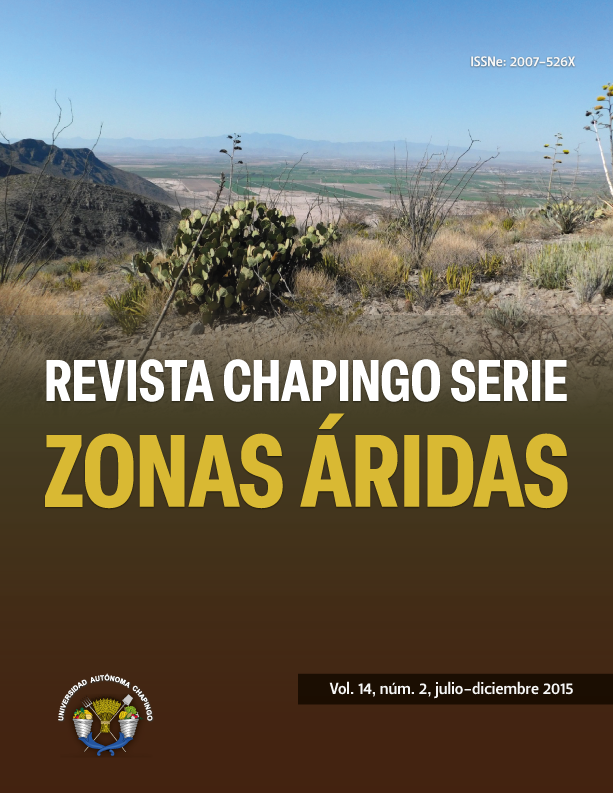Resumen
El sector agrícola genera impactos en el medio ambiente por la liberación de gases efecto invernadero (GEI), considerados factores potenciales para el aumento del calentamiento global. El carbono orgánico del suelo tiene una importante repercusión sobre las emisiones de GEI, debido a que la pérdida de materia orgánica del suelo repercute en la liberación de CO2, principal gas emitido a la atmósfera. El objetivo de este trabajo fue predecir el potencial de emisión de CO2 a partir del carbono orgánico total (COT) del suelo de algunas zonas agrícolas pertenecientes a las cuencas “Arroyo La India”, “Arroyo Cerro Gordo” y “Arroyo de Naitcha” del estado de Durango, mediante estimaciones basadas en los modelos del IPCC. La concentración promedio de COT en los sitios de estudio fue de 1.33 %, mientras que el potencial de emisión de CO2 fue de 0.032 Gg correspondiente a un 1.03 % del total de emisión de suelos del estado de Durango.
Citas
Álvaro, J.; Cantero, C.; López, M. V.; Arrué, J. L. (2010). Fijación de Carbono y reducción de emisiones de CO2. Agricultura de Conservación: Aspectos agronómicos y medioambientales. Eumedia (eds.). España. pp. 89-96.
Bueno, P. (2012). Trabajo de tesis de maestría: Cuantificación de la emisión y captura de GEI en el sector USCUSyS mediante la metodología del IPCC en el estado de Durango. Universidad Autónoma Chapingo. Unidad Regional Universitaria de Zonas Áridas.
Cole, C. V. (1996). Agricultural options for mitigation of greenhouse gas emissions. Chapter 23. pp. 745-771.
Fernández, R. O.; Bojollo, R. C. (2008). Inf luencia de la climatología y el manejo del suelo en las emisiones de CO2 en un suelo arcilloso de la Vega de Carmona. Carel: Carmona: Revista de estudios locales, (6), 2339-2354.
IPCC. (2011). Sobre nosotros. Fecha de acceso: 3/05/2015. Disponible en: http://www.ipcc.ch/home_languages_main_spanish.shtml#1
IPCC. (1996). Directrices del IPCC para los inventarios de gases de efecto invernadero, versión revisada en 1996: Libro de trabajo. Panel Intergubernamental de Cambio Climático.
Lal, R. (1997). Residue management, conservation tillage and soil restoration for mitigating greenhouse effect by CO2- enrichment. Soil Till. Res., 43: 81 – 107.
Norma Oficial Mexicana (2000). NOM-021-SEMARNAT-2000 que establece las especificaciones de fertilidad, salinidad y clasificación de suelos, estudio, muestreo y análisis.
Paustian, K.; Collins, H. P.; Paul, E. A. (1997). Management controls on soil carbon. In: Paul, E. A., Paustian, K., Elliot, E. T., Cole, C. V. (Eds) Soil Organic Matter in Temperate Agroecosystems: Long-term Experiments in North America (pp 15-49). CRC Press, Boca Raton, FL, USA.
Sandoval, Estrada, M.; Stolpe, Lau, N.; Zagal, Venegas, E.; Mardones, Flores, M.; Junod, Montano, J. (2003). El secuestro de carbono en la agricultura y su importancia con el calentamiento global. The Carbon Sequestration in Agriculture and its Importance in Global Warming. Theoria, . 65-71.
Walkley, A.; Black, I. A. 1934. An examination of the Degtjareff method for determining soil organic matter and a proposed modification of the chromic acid titration method. Soil Science 37: 29-38.
Weihermüller, L.; Lamers, M.; Reichstein, M. 2011. Introduction to production, transport, and emission of trace gases from the vadose zone to the atmosphere. Vadose Zone Journal. Vol. 10 pp. 151-155
Zhang, X.; Li, L.; Pan, G. 2007. Topsoil organic carbon mineralization and CO2 evolution of three paddy soils from South China and the temperature dependence. Journal of Environmental Sciences. 19:319-326

Esta obra está bajo una licencia internacional Creative Commons Atribución-NoComercial 4.0.
Derechos de autor 2015 Revista Chapingo Serie Zonas Áridas



